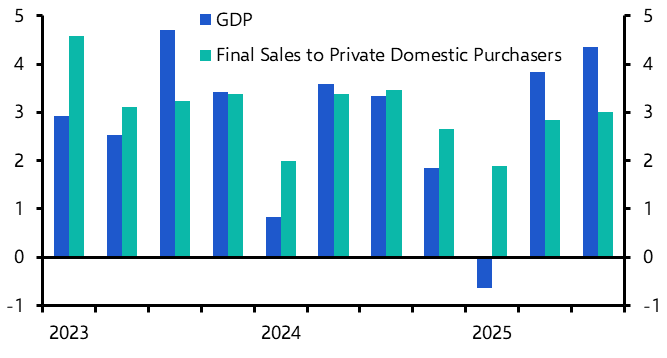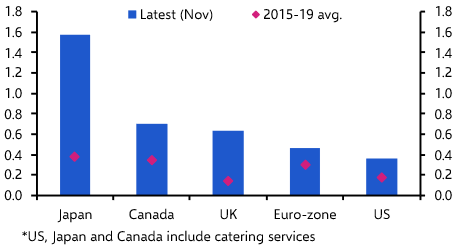Last week we published our latest Global Economic Outlook. Two themes stand out. The first, as I have discussed before, is that we expect the recovery in global output over the next couple of years to be significantly stronger than most anticipate. The second is that we anticipate a relatively sharp rebound in inflation in developed markets over the first half of this year. According to our forecasts, headline consumer price inflation in advanced economies is set to pick up from a recent low of 0.4% y/y in November to 2% y/y by May.
Does this mean that the world is on the cusp of a post-pandemic era of higher inflation? The short answer is “no” or, perhaps more accurately, “not yet”.
When thinking about inflation, it is important to distinguish between widespread increases in prices that are sustained over many years and one-off increases in prices that can cause short-lived moves in the inflation rate. The former occurs when policymakers allow demand to run ahead of supply for a prolonged period. The latter can be caused by everything from fluctuations in global energy and agricultural prices, to movements in exchange rates and changes to indirect taxes.
The rise in inflation we anticipate this year falls into the second category. The most important driver will be a rebound in energy inflation, caused by the recovery in global oil prices from the lows seen in spring of last year. This alone could add over 1%-pts to headline inflation in advanced economies. The unwinding of last year’s VAT cuts in Germany and the UK will push up inflation in those countries too. And on top of this, the recent surge in shipping costs may push up the price of imported manufactured goods in the US and Europe as well.
All of this produces the rebound in headline inflation over the first half of this year that is shown in Chart 1. But at the same time, and as the chart also shows, core inflation should remain well anchored.
Chart 1: Advanced economy consumer price inflation (% y/y)

This in part reflects the large amount of spare capacity created by the slump in output during the pandemic. This varies between countries – for example, there is currently less slack in the US economy than there is in the UK or the euro-zone. But even so, output gaps across the developed world will persist this year, meaning there will be substantial amounts of under-utilised resources that firms can draw upon to raise output during the recovery without putting upward pressure on prices.
More fundamentally, debates around inflation often ignore the fact that core inflation in advanced economies has remained stubbornly flat in recent decades. Over the past twenty years the world economy has experienced a credit-led boom, a housing-led bust, the widespread embrace of quantitative easing, a decade-long recovery, and a global pandemic – and yet core inflation in the developed world has barely budged from a range of 1-2% y/y. (See Chart 2.)
Chart 2: Advanced economy core price inflation (% y/y)

That is not to say it will not break out of this range in future. It’s just that it would be wrong to interpret the rebound in advanced economy inflation that we anticipate over the next six months as the start of a new era of higher inflation. Indeed, as the Chart 1 shows, we expect inflation in advanced economies to drop back in early 2022 as the temporary factors that combine to push it up this year start to wear off. This means that central banks should look through the impending jump in inflation and keep policy support in place.
It remains to be seen whether, against a backdrop of rising inflation concerns, the bond markets hold their nerve. We suspect that, for the most part, they will and that yields will remain anchored at current low levels. It also remains to be seen whether, after this year’s head-fake, inflation does pick up on a more sustained basis later in this decade. On this we are less sanguine – and it’s something to which I’ll return to in next week’s note.
In case you missed it:
- Our Chief Europe Economist, Andrew Kenningham, cuts through the fog of last week’s ECB press conference.
- Our Emerging Markets Economist, Liam Peach, looks at the challenges facing vaccine rollout in Emerging Europe.
- Our US team has incorporated fiscal stimulus into its forecasts – pushing us further above the consensus for this year.
- Finally, a reminder that you can track daily data on infections, vaccine rollout and economic activity on our dedicated webpage.



